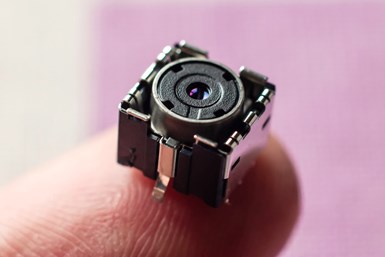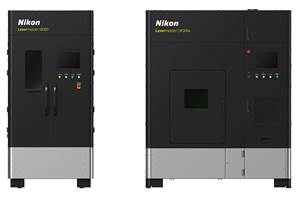Horizon Microtechnologies’ Micro AM for Conductive, Environmentally Resistant Parts
The company has developed a template-based 3D microfabrication technology that gives manufacturers the ability to add conductivity to all or selected parts of a 3D-microfabricated template.
Horizon Microtechnologies has developed a template-based 3D microfabrication technology that gives manufacturers the ability to add conductivity to all or selected parts of a 3D-microfabricated template. Photo Credit: Horizon Technologies
Horizon Microtechnologies says its template-based 3D microfabrication technology is effectively a mechanism to exploit the usefulness of polymer micro additively manufactured (micro AM) 3D microstructures (the template). This technology is well suited for previously unserved areas of industry by adding material and functionality to the microstructure, typically with a coating process.
The company says it is now involved in numerous application-specific discussions with manufacturers across a variety of industry sectors. It is said the technology meets the demand from companies that want to benefit from the advantages and opportunities that exist through the use of micro AM, but want parts that have functionality impossible due to limited palette of materials that micro AM is able to process.
“We have researched and developed our template-based 3D microfabrication technology over many years, and while this is done in consultation with manufacturers and sensitive to market demands and dynamics, only when you commercially launch can you see and assess the level of real practical interest,” says Andreas Frölich, Horizon Microtechnologies CEO. “Since announcing the commercial availability of our technology, we have been somewhat overwhelmed by the highly qualified and application-specific nature of the conversations we are now having with customers.”
Frölich says the reason for this is to be expected in that its technology largely enhances the functionality of additive manufacturing (AM), specifically micro AM, which has only recently evolved into a repeatable and reliable area of AM for industrial applications.
“AM has been recognized across industry as affording manufacturers access to an agile, cost-effective and versatile technology that promotes hitherto impossible geometric complexity while at the same time democratizing manufacturing,” Frölich adds. “Our template-based 3D microfabrication technology opens up the power of AM to sectors that were until now unable to exploit it due to restricted material options, which, in turn, restricted part functionality.”
Horizon Microtechnologies has developed a post-build coating technology that builds upon the opportunities afforded through the use of micro AM-produced parts by adding functionality, specifically conductivity and environmental resistance. To introduce conductivity, once the part is produced on a polymer AM platform, it is either wholly or selectively coated with a conductive layer.
The company can even coat difficult areas homogeneously, such as long narrow channels and undercuts. In addition, microfabricated 3D templates can also be coated with metal oxides to make parts compatible with aggressive chemical environments and, in some cases, can notably increase the resistance to high temperatures and mechanical stresses. The ability to add conductivity to all or selected parts of a 3D microfabricated template is well suited for manufacturers of electrodes, electrical sensor heads and ESD-safe components.
“When focused specifically on electrodes, we are able to design an electrode geometry almost arbitrarily while maintaining manufacturability through the use of micro AM 3D templates,” Frölich says. “Using micro AM as opposed to traditional manufacturing processes allows for more flexibility when it comes to 3-dimensional placement of active electrode areas, stiffness (or lack of stiffness) of the electrodes and electrical properties of the electrode due to enhanced control over the inductance and capacitance. We also have the ability to make electrodes from different conductive materials to cater for biocompatibility/bioinertness.”
While Horizon’s coating process is agnostic to part geometry and complexity, if selective coating is required, this needs to be accounted for at the design stage of product development. Because of this, Horizon works with customers to optimize outcomes using design for micro AM and design for template-based microfabrication expertise.
- Listen to this episode of AM Radio as Peter Zelinski and Julia Hider zoom in on micro 3D printing, including discussion of the opportunities and challenges of 3D printing on a micro scale.
Related Content
Nikon Lasermeister Metal DED 3D Printer and Scanner Developed for Industrial Applications, Turbine Blade Repair
This technology gives manufacturers the ability to build onto existing parts with high precision and utilize a variety of materials, reducing lead times and minimizing postprocessing requirements.
Read MoreHeat Exchangers 3D Printed from Haynes Alloy: The Cool Parts Show Bonus
Heat exchangers used in concentrated solar power must withstand elevated temperatures and pressures, and 3D printing enables the use of materials appropriate to this application.
Read More3D Printed Reactor Core Makes Solar Fuel Production More Efficient
The solar reactor uses water and CO2 from the air and sunlight as the energy source to produce carbon-neutral liquid fuels, for example, solar kerosene for aviation.
Read MoreVideo: AM for Repair of Large Shafts
Wind power shafts that might once have been scrapped are now returned to service. See the robotic directed energy deposition (DED) and shaft preheating system developed by Ikergune, Izadi and Talens.
Read MoreRead Next
Postprocessing Steps and Costs for Metal 3D Printing
When your metal part is done 3D printing, you just pull it out of the machine and start using it, right? Not exactly.
Read More3D Printed Polymer EOAT Increases Safety of Cobots
Contract manufacturer Anubis 3D applies polymer 3D printing processes to manufacture cobot tooling that is lightweight, smooth and safer for human interaction.
Read MoreAlquist 3D Looks Toward a Carbon-Sequestering Future with 3D Printed Infrastructure
The Colorado startup aims to reduce the carbon footprint of new buildings, homes and city infrastructure with robotic 3D printing and a specialized geopolymer material.
Read More





















